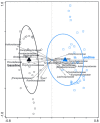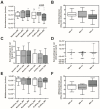Multi-Nutrient Fortified Dairy-Based Drink Reduces Anaemia without Observed Adverse Effects on Gut Microbiota in Anaemic Malnourished Nigerian Toddlers: A Randomised Dose-Response Study
- PMID: 34066577
- PMCID: PMC8148581
- DOI: 10.3390/nu13051566
Multi-Nutrient Fortified Dairy-Based Drink Reduces Anaemia without Observed Adverse Effects on Gut Microbiota in Anaemic Malnourished Nigerian Toddlers: A Randomised Dose-Response Study
Abstract
Prevalence of anaemia among Nigerian toddlers is reported to be high, and may cause significant morbidity, affects brain development and function, and results in weakness and fatigue. Although, iron fortification can reduce anaemia, yet the effect on gut microbiota is unclear. This open-label randomised study in anaemic malnourished Nigerian toddlers aimed to decrease anaemia without affecting pathogenic gut bacteria using a multi-nutrient fortified dairy-based drink. The test product was provided daily in different amounts (200, 400 or 600 mL, supplying 2.24, 4.48 and 6.72 mg of elemental iron, respectively) for 6 months. Haemoglobin, ferritin, and C-reactive protein concentrations were measured to determine anaemia, iron deficiency (ID) and iron deficiency anaemia (IDA) prevalence. Faecal samples were collected to analyse gut microbiota composition. All three dosages reduced anaemia prevalence, to 47%, 27% and 18%, respectively. ID and IDA prevalence was low and did not significantly decrease over time. Regarding gut microbiota, Enterobacteriaceae decreased over time without differences between groups, whereas Bifidobacteriaceae and pathogenic E. coli were not affected. In conclusion, the multi-nutrient fortified dairy-based drink reduced anaemia in a dose-dependent way, without stimulating intestinal potential pathogenic bacteria, and thus appears to be safe and effective in treating anaemia in Nigerian toddlers.
Keywords: Nigeria; anaemia; iron deficiency; iron deficiency anaemia; malnourished; microbiota; multi-nutrient fortified dairy-based drink; toddler.
Conflict of interest statement
At the time of this study, A.J.O. was employed by FrieslandCampina WAMCO Nigeria, A.S. and J.H.J.H. are employees of FrieslandCampina, no other conflict of interest.
Figures



Similar articles
-
Multi-micronutrient Sprinkles including a low dose of iron provided as microencapsulated ferrous fumarate improves haematologic indices in anaemic children: a randomized clinical trial.Matern Child Nutr. 2006 Jul;2(3):169-80. doi: 10.1111/j.1740-8709.2006.00060.x. Matern Child Nutr. 2006. PMID: 16881929 Free PMC article. Clinical Trial.
-
Iron fortification adversely affects the gut microbiome, increases pathogen abundance and induces intestinal inflammation in Kenyan infants.Gut. 2015 May;64(5):731-42. doi: 10.1136/gutjnl-2014-307720. Epub 2014 Aug 20. Gut. 2015. PMID: 25143342 Clinical Trial.
-
Efficacy of a multi micronutrient-fortified drink in improving iron and micronutrient status among schoolchildren with low iron stores in India: a randomised, double-masked placebo-controlled trial.Eur J Clin Nutr. 2013 Jan;67(1):36-41. doi: 10.1038/ejcn.2012.188. Epub 2012 Dec 12. Eur J Clin Nutr. 2013. PMID: 23232585 Clinical Trial.
-
Health effects of micronutrient fortified dairy products and cereal food for children and adolescents: A systematic review.PLoS One. 2019 Jan 23;14(1):e0210899. doi: 10.1371/journal.pone.0210899. eCollection 2019. PLoS One. 2019. PMID: 30673769 Free PMC article.
-
Intermittent iron supplementation for reducing anaemia and its associated impairments in adolescent and adult menstruating women.Cochrane Database Syst Rev. 2019 Jan 31;1(1):CD009218. doi: 10.1002/14651858.CD009218.pub3. Cochrane Database Syst Rev. 2019. PMID: 30699468 Free PMC article.
Cited by
-
Effect of a Fortified Dairy-Based Drink on Micronutrient Status, Growth, and Cognitive Development of Nigerian Toddlers- A Dose-Response Study.Front Nutr. 2022 Apr 27;9:864856. doi: 10.3389/fnut.2022.864856. eCollection 2022. Front Nutr. 2022. PMID: 35571933 Free PMC article.
-
A Scoping Review Evaluating the Current State of Gut Microbiota Research in Africa.Microorganisms. 2023 Aug 20;11(8):2118. doi: 10.3390/microorganisms11082118. Microorganisms. 2023. PMID: 37630678 Free PMC article.
-
Intestinal Microbiota in Children with Anemia in Southern Peru through Next-Generation Sequencing Technology.Children (Basel). 2022 Oct 25;9(11):1615. doi: 10.3390/children9111615. Children (Basel). 2022. PMID: 36360343 Free PMC article.
-
Exploring disparities in malnutrition among under-five children in Nigeria and potential solutions: a scoping review.Front Nutr. 2024 Jan 5;10:1279130. doi: 10.3389/fnut.2023.1279130. eCollection 2023. Front Nutr. 2024. PMID: 38249616 Free PMC article.
-
The Effect of Oral Iron Supplementation/Fortification on the Gut Microbiota in Infancy: A Systematic Review and Meta-Analysis.Children (Basel). 2024 Feb 10;11(2):231. doi: 10.3390/children11020231. Children (Basel). 2024. PMID: 38397343 Free PMC article. Review.
References
-
- Petry N., Olofin I., Hurrell R.F., Boy E., Wirth J.P., Moursi M., Angel M.D., Rohner F. The proportion of anemia associated with iron deficiency in low, medium, and high human development index countries: A systematic analysis of national surveys. Nutrients. 2016;8:693. doi: 10.3390/nu8110693. - DOI - PMC - PubMed
-
- WHO . Nutritional Anaemias: Tools for Effective Prevention. WHO; Geneva, Switzerland: 2017.
Publication types
MeSH terms
Substances
Grants and funding
LinkOut - more resources
Full Text Sources
Medical
Research Materials

